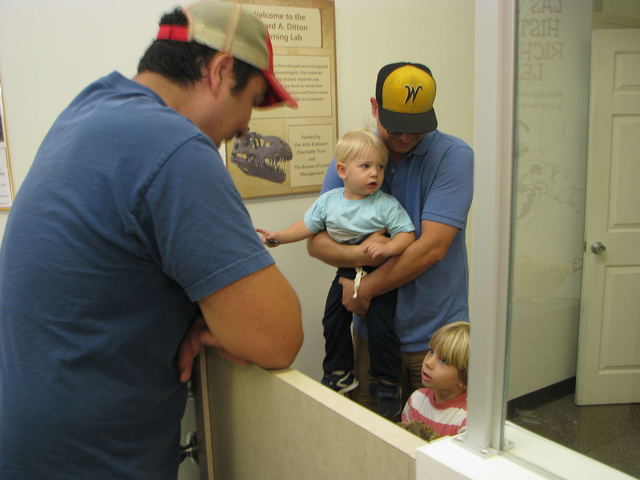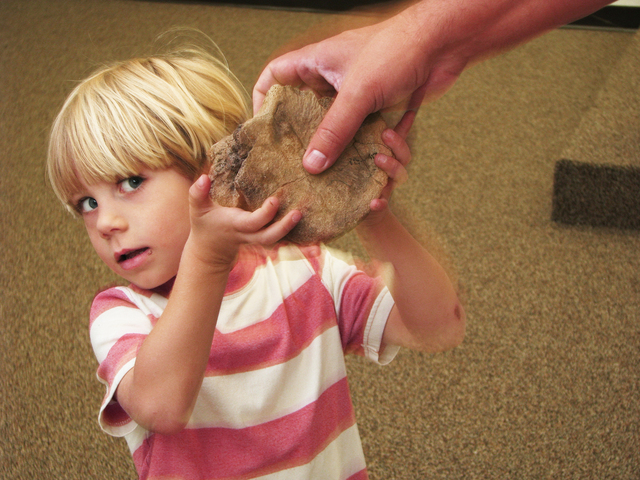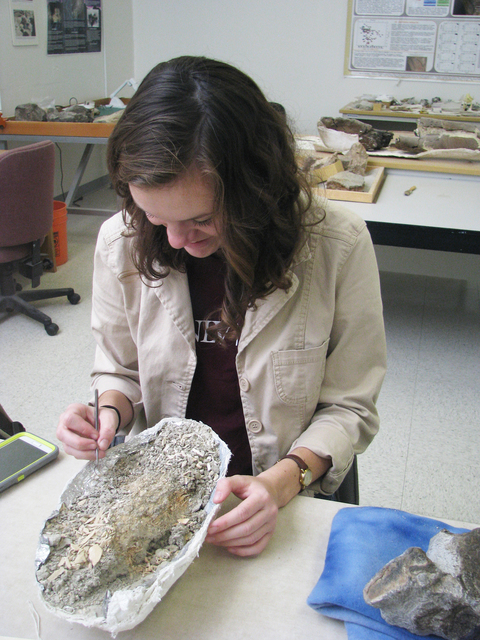Hands-on Ditton Learning Lab gives youths experience with fossils
Nathan Harper’s 6-year-old son Cassius looked incredulous as the Las Vegas Natural History Museum’s resident paleontologist, Joshua Bonde, handed him a 68-million-year-old piece of triceratops backbone.
“If a guest shows up here and doesn’t get to hold a dinosaur bone, it means I wasn’t here,” said Bonde, a UNLV geoscience professor. “I think every guest who wants to should be able to say they held a dinosaur bone.”
The Harpers and Bonde were in the Richard Ditton Learning Lab, a 1,200 square-foot space that was recently converted into a working laboratory at the museum. A half wall topped with some plexiglass divides student volunteers from the public, but a set of steps along the wall allows young children to watch the cleaning and conservation of ancient fossils from Nevada.
“I was on my way to my office at the Springs Preserve with the kids and they insisted we stop here,” said Harper, an archaeologist at Springs Preserve. “Cassius calls it the ‘natural mystery museum.’ We come here a lot.”
“Any fossil not being worked on in this lab, we’re losing to out of state,” Bonde said. “It’s a legacy from when we couldn’t take care of our own resources and fossils found here were shipped off to California, New York or Chicago. They’re perfectly good museums, but now we can do it here and we hope to continue and expand.”
Bonde cited several prominent fossil collections, including historic finds from nearby Gypsum Cave, that have been in California since the 1930s and what he says is one of the finest ancient bison skulls he’s ever seen, now housed in Canada.
Bonde noted that because of a working relationship with the Nevada Division of State Parks and the Bureau of Land Management, fossils found in Southern Nevada are now coming to the museum’s laboratory.
He pointed out a number of items being worked on at the moment including; part of a vertebrae from a crocodile-sized salamander-like animal from about 230 million years ago; found in Spring Mountain Ranch State Park; part of the skull of a duck-billed dinosaur showing two rows of replacement teeth; camel bones from Tule Springs; the 16-million-year-old partial skull of a gonthier; an elephant-like animal that had four tusks and 100-million-year-old plant impressions found in Valley of Fire State Park.
“You can see the magnolia impressions here,” Bonde said. “A volcano in Southern California dropped a lot of ash on Southern Nevada and gave us kind of a snapshot of the ecosystem. As cool as it might be to dig up a mammoth, it’s the little things that tell us more about the environment.”
Undergraduates from UNLV have been carefully screening sediment from Tule Springs, looking for small shells, bones and teeth. Specimens can be observed through a microscope that is linked to a monitor mounted to the wall, so visitors can see exactly what the volunteer is seeing.
Bonde joined the board of directors five years ago and took on the task of creating a research program at the museum. With the help of the city, the museum acquired a building to store the museum’s undisplayed collections, particularly the archaeological and paleontological collections. The working laboratory is where the previous collections space was.
Volunteer archaeology and paleontology students from UNLV and the College of Southern Nevada work together cleaning and preparing the fossils and talking with visitors.
“I want students to be able to learn how to interact with the public because often times scientists aren’t very socially outgoing,” Bonde said. “I think that learning how to convey science to the public is a really important thing, especially in paleontology.”
UNLV student Susie Hertfelder was engaged in intricate work on a mammoth tusk recently.
“Tusks are really fragile,” Hertfelder said. “It’s really an elongated tooth. They tend to break into small, thin fragments. I’m trying to remove all of the sediment while keeping the fossil intact. It takes a long time, but as long as you’re slow and you’re careful, it goes pretty well.”
The lab had its grand opening Oct. 8 and is currently open four days a week, based on student volunteers scheduled. It is also open whenever Bonde can be there. He hopes to have it open seven days a week as soon as he can bring in more volunteers. A science background is not required, and Bonde said that he will consider and train passionate laypeople, including high school students who are reliable.
Those interested in volunteering can visit nvpaleo.weebly.com.
The Richard Ditton Learning Lab is located at Las Vegas Natural History Museum, 900 Las Vegas Blvd. North. Visit lvnhm.org or call 702-384-3466.
To reach East Valley View reporter F. Andrew Taylor email ataylor@viewnews.com or call 702-380-4532.

























